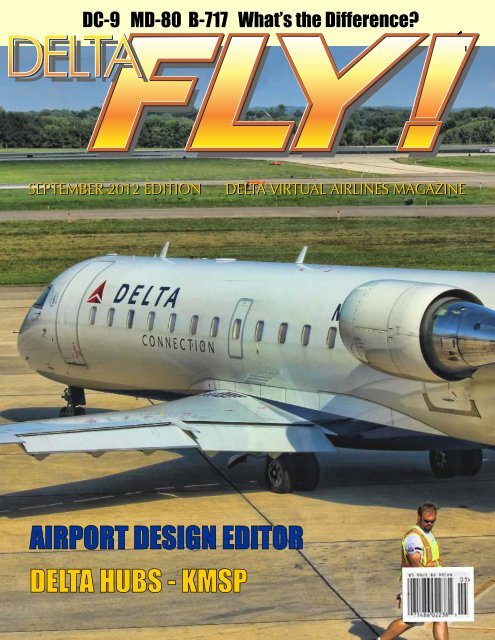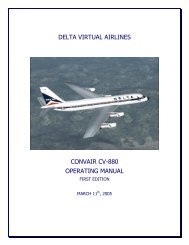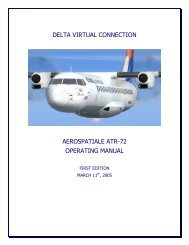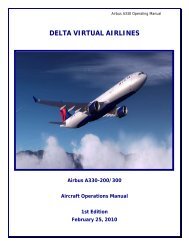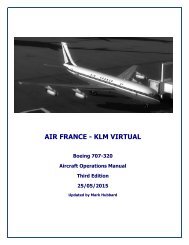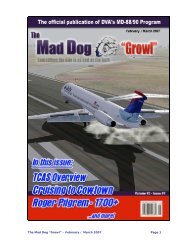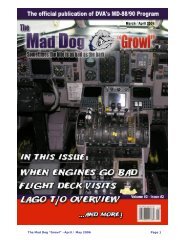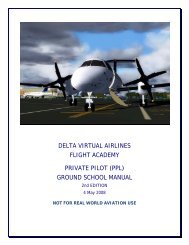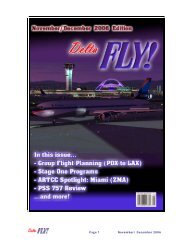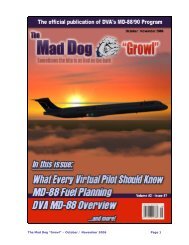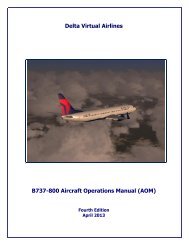September 2012 - Delta Virtual Airlines
September 2012 - Delta Virtual Airlines
September 2012 - Delta Virtual Airlines
You also want an ePaper? Increase the reach of your titles
YUMPU automatically turns print PDFs into web optimized ePapers that Google loves.
DC-9 MD-80 B-717 What’s the Difference?SEPTEMBER <strong>2012</strong> EDITIONDELTA VIRTUAL AIRLINES MAGAZINEAIRPORT DESIGN EDITORDELTA HUBS - KMSP
August 2011<strong>September</strong> <strong>2012</strong>Issue #16Editor - Tom Houswortheditor@deltava.orgPilot Interviewer - Elise Van de PutteFront Cover: CRJ200 taxiing out for departure from KLSEcourtesy of Mathias LundPhotos and Screenshots courtesy of:Fly <strong>Delta</strong> Jets by Jim Wilkinson.........pg 2A319 at KMSP by FlightAware..........pg 4DC9-MD80-B717 by Kyle Dunst..... pg 5-7A380 at CYUL by Craig McGrath.... pg 10B787 Cockpit by Don Thomas......... pg 11Japan trip by Elise Van de Putte....pg 15-17In-N-Out spotting by FlightAware.....pg 17Parting Shots by FlightAware.............pg 20If you want your photo to be considered for use in a futureedition of <strong>Delta</strong> FLY!, send an email to the address listedin this section with the subject: <strong>Delta</strong> FLY! Photo.Please do not send the photo itself, but instead provide alink to the photo (i.e., from the Water Cooler). If you haveto send the photo itself, send it to editors email addresslisted above.Photos must be your own work. Please do notrecommend photos that are not yours. Photo copyrightsbelong to the original author and will not be used withoutpermission. If you want a photo to be used as filler within<strong>Delta</strong> FLY!, the same rules apply.INSIDE THIS ISSUE:Inside This Issue pg 2President’s Letter pg 3<strong>Delta</strong> Hubs pg 4DC9-MD80-B717 pg 5-7Newbies pg 8Pilot Interview pg 9-10From the Editors Desk pg 11Airport Design Editor pg 12-14Trip to Japan pg 15-17Face with a Name pg 18-19Parting Shots pg 20<strong>Delta</strong> <strong>Virtual</strong> <strong>Airlines</strong> (DVA) is in no way affiliated with <strong>Delta</strong> Air Lines or any of its subsidiaries. The information contained in thisdocument is for flight simulation use only. This document is freeware only.All Rights Reserved. This publication may not be reproduced, in part or its entirety, without the expressed permission of DVA andthe Editor. Images used are copyrighted by their respective owners.2SEPTEMBER <strong>2012</strong>
From thePresidents DeskTerry Eshenour - Senior Captain B777August <strong>2012</strong>Fellow Pilots,Our pilots and support staff are energetic and busy flying, taking check rides and learning about aviation. Wehave 2,031 active pilots that flew a total of 7,605 flights in the month August for a daily average of 245 flights.<strong>Delta</strong> <strong>Virtual</strong> <strong>Airlines</strong> in 2011 became one of eight VATSIM certified training organizations to administer the P1Online Pilot certification. DVA Flight Academy trained almost one-half of the P1 graduates last year. Thefinishing touches to VATSIM P2 Flight Fundamentals and P3 VFR Pilot Course curriculum are underway. Youwill be informed when we are VATSIM certified.The Career Opportunities section greatly enhances the receipt and processing of job applications. Interested insupporting the community at the staff level? I urge you to apply for openings that you feel suited. Should younot succeed at first, continue to apply. We have a large talent pool and only a few positions. Be patient and yourtime to serve will come.Tom Housworth, Editor <strong>Delta</strong> Fly!, recently was promoted to Chief Pilot B757 when long-time serving MarkSpringsteen retired. Tom continues to assemble and publish a first class, professional magazine but needsassistance. Have an aviation related idea or an experience to share, prepare a draft or an outline for Tom toreview.The operations group was busy updating aircraft operating manuals and putting together a fifth stage in oursystem that will roll out shortly. Expect to hear more about the expansion of our program in the months tocome.I provided last year at this time a description of our finances. The volunteer contributions were strong enablingthour operation to continue through its 11 year advertising free. As we close the current fiscal year we have apositive balance of funds. Last year's contributors can expect a Treasurer's report shortly.Wishing you all blue sky and smooth air!Thank you for flying <strong>Delta</strong> <strong>Virtual</strong> <strong>Airlines</strong>,Terry EshenourPresident, Senior CaptainDVA0573SEPTEMBER <strong>2012</strong>
KMSP - <strong>Delta</strong>’s 3rd Largest HubMinneapolis-Saint Paul International Airport (IATA: MSP, ICAO: KMSP, FAA LID:MSP) is a joint civil-military public use airport. Located in an unincorporatedpart of Hennepin County, Minnesota, within ten miles (16 km) of bothdowntown Minneapolis and downtown Saint Paul, it is the largest and busiestairport in the five-state upper Midwest region of Minnesota, Iowa, SouthDakota, North Dakota, and Wisconsin.The airport first came into being when several local groups came together totake control of the former bankrupt Twin City Speedway race track, giving theairport its original name, Speedway Field. Soon after, in 1921, the airport wasrenamed Wold-Chamberlain Field for the World War I pilots Ernest GrovesWold and Cyrus Foss Chamberlain. Howard Hughes briefly stopped at Wold-Chamberlain Field on his round the world flight in 1938. In 1944, the site wasrenamed Minneapolis-St. Paul Metropolitan Airport/Wold-Chamberlain Field,with "International" replacing "Metropolitan" four years later. Today, it is veryrare to see the Wold-Chamberlain portion of the name used anywhere.MSP was the main base for Northwest <strong>Airlines</strong> starting in 1926, and becamethe main base of regional carrier North Central <strong>Airlines</strong> in 1952. North Centralmerged with Southern Airways to form Republic <strong>Airlines</strong> in 1979; Republicthen merged with Northwest in 1986. The combined carrier came to control79% of traffic at the airport, and merged into <strong>Delta</strong> Air Lines in 2010.The 1970, the disaster film Airport was partially filmed at MSP, filling in for afictional Lincoln airport. It was followed by several sequels and was a prototypefor many disaster films that followed. The airport used colors as the method fornaming different concourses for many years, a convention that was duplicatedin the movie.Minneapolis/Saint Paul International Airport has two terminals, both of whichwere named for famous Minnesotans: the Lindbergh Terminal (named after theaviator Charles Lindbergh) and the smaller Humphrey Terminal (named forformer US Vice President Hubert Humphrey.)Information courtesy of Wikipedia2011Statistics12th busiestairfield in theUnited States15th in NorthAmerica forthe number oftravelersservedPassengers33,118,499TrafficMovements436,506DELTA HUBS4SEPTEMBER <strong>2012</strong>
DC-9, MD-80, B-717......What’s the difference?By Kyle Dunst of thirtythousand.us an aviation related blogTo the untrained eye, the three aircraft pictured below might look like they are the exact same type. Unless you are aserious aviation enthusiast, you probably can't tell the difference between them at first glance. If you have ever wonderedwhat the differences are between the Douglas DC-9, McDonnell Douglas MD-80, and the Boeing 717, then keepreading. But first, see if you can guess which aircraft is which.If you guessed the top was a DC-9, the middle a B-717, and the bottom an MD-80, you were right. The truth is that allthese aircraft were based off the Douglas DC-9, and together are considered the "DC-9 Family."5SEPTEMBER <strong>2012</strong>
A brief history...The first of the type, the Douglas DC-9, was first introduced into service with <strong>Delta</strong> <strong>Airlines</strong> in 1965. It wasdeveloped by the Douglas Aircraft Company for airlines to use on short but frequent routes. Its main feature was theability to utilize short runways, which allowed for the introduction of jet service to smaller airports that previouslyonly saw propeller driven aircraft. Over 900 of the type were produced with the last delivery in 1982. Today, themain operators of the aircraft are <strong>Delta</strong> <strong>Airlines</strong> and USA Jet. They are slowly being phased out of fleets and willprobably be nonexistent within the next couple of years.A <strong>Delta</strong> <strong>Airlines</strong> Douglas DC-9-50 climbing off ofRunway 26L at Atlanta. (Photo by Kyle Dunst)The next generation of the aircraft was originally supposedto be designated the DC-9-80 "Super 80." However, afterDouglas merged with McDonnell Aircraft, its name was changed to the McDonnell-Douglas MD-80. The MD-80,and the later MD-90 variation, were much larger than the DC-9 they were based off of. The first of the type enteredservice with Swissair and Austrian <strong>Airlines</strong> in 1980. About1,000 aircraft were produced in total, making it the mostpopular aircraft of the DC-9 Family. The largest operatorsof the type are American <strong>Airlines</strong> and <strong>Delta</strong> <strong>Airlines</strong> withabout 200 and 100 aircraft respectively.A <strong>Delta</strong> MD-88 Lining up for departure on Runway 18Cat Charlotte (Photo by Kyle Dunst)The most recent of the DC-9 Family is the Boeing 717. Only 156 of the type were produced, making it the leastpopular of the series. The last two of the type were delivered in 2006 to AirTran and Midwest <strong>Airlines</strong>, marking theend of one of the most historic and popular aircraft series the world has ever seen. Just like the MD-80, the B-717'sname came from a company merger. This time, the McDonnell-Douglas aircraft corporation was absorbed by BoeingCommercial Airplanes in 1997. The main improvement of the B-717 over previous types is the state of the art,modern flight deck. It features 6 interchangeable LCD Displays and advanced computers. The largest operator of thetype by far is AirTran. As the airline is absorbed intoSouthwest <strong>Airlines</strong>, the B-717s will be transferred to<strong>Delta</strong>. This means that starting next year, <strong>Delta</strong> willoperate all 3 types of the DC-9 Family.AirTran Orlando Magic NBA Team B-717-200 Logo Jetseen at Atlanta (Photo by Kyle Dunst)6SEPTEMBER <strong>2012</strong>
How to tell the difference...So now that you know how each variation of the DC-9 Family came to exist, you probably want to know how you canactually tell the three apart. Each variant has a few unique characteristics, both inside and out.The DC-9 has much smaller engines than the other two. It also features apointier tail cone. On the other hand, the B-717 has large, bulky, powerfulengines with a more rounded tail cone. The MD-88 combines thecharacteristics of the DC-9 and B-717, which makes sense as it served as atransition between the two.Note the large, bulky engines and round tail cone on this AirTran B-717.(Photo by Kyle Dunst)The MD-88 has the tail cone of a B-717, but smaller engines similar tothat of a DC-9The best way to distinguish an MD-80 from the other two, is that it is much longer with a much wider wing span. DC-9'sand B-717's are about 124 feet long, depending on the specific variant, with a wingspan of 93 feet. The MD-88 is animpressive 148 feet long with a 108 foot wingspan.For people with a decent amount of knowledge about commercial aviation, the easiest way to tell the difference is bywhat airline is operating it. For example, American <strong>Airlines</strong> only operates the MD-80 and AirTran now only operates theBoeing 717. As you become more involved in the aircraft spotting hobby, you quickly learn which airlines operate whichtypes of aircraft. <strong>Delta</strong>, on the other hand, will soon operate the DC-9, MD-80, and B-717. (So much for that method...)From the inside you can sometimes tell the difference by the seating layout. <strong>Delta</strong>'s MD-80's have three seats on the leftside of the aisle and two on the right, while its DC-9's are the other way around. The B-717's cockpit is very unique andrecognizable as compared to the other two.Next time you find yourself at an airport, try to see if you can figure out which is which.7
PILOT INTERVIEWby Elise Van de PutteFeaturingLuke Kolin1. When did you start using flight simulators?I first saw MS Flight Simulator on a PC in 1983 or 1984. This was CGA-style graphics so four colors and wireframerendering of the Chicago area, but I was hooked. I didn't manage to get another flight simulator until I got a versionfor the Apple 2 a few years later, which was a cruder graphics-wise. From then it was over a decade until I startedsimming again in 2000.2. What's in your hangar?A variety of aircraft. I have the LDS 767 and the PMDG 737/747, plus the DF727 for payware. I still fly a largeamount of the DVA/AFV fleet including the 707, DC-8, 747, DC-9 and CV-880/990. I'm contemplating my nextpurchase, and I'm undecided between the PMDG MD-11 or the 737. I'm also looking for a good 757.3. What's your favorite flight?That's a great question - it's interesting how that can change over time! I suspect for sheer frequency it would be YYZ-ATL, or the return flight. I have a lot of family and friends in the Toronto area so I've flown that flight in real lifedozens of times. One of the fun aspects of flight simulation is that you can compare your operations to the realthing, and with this flight I have lots of material to compare to! One other challenge is to see if I can overfly theneighborhoods of my parents on the approach into 24L in Toronto - each time I visit I see a stream of aircraft flyingover about to turn towards the airport. One day I'll overfly their homes.Probably my second favorite flight is LAX-OGG. The approach into Kahului is through a valley between two extinctvolcanoes - the scenery is quite spectacular in stock FSX and it's an enjoyable approach to fly manually. There's apretty consistent stiff breeze from the trade winds that adds a wrinkle, too.4. What attracted you to <strong>Delta</strong> <strong>Virtual</strong>?When I got interested in virtual aviation, it came down to two choices - either <strong>Delta</strong> or Air Canada. My father-in-lawworked for Air Canada for a quarter-century, and I grew up watching a variety of Air Canada and CP Air aircraft inthe 1970s and 1980s with my father at the top of the Toronto airport parking garage. I chose <strong>Delta</strong> for two reasons -there wasn't a head and shoulders superior <strong>Delta</strong> virtual airline in existence, and between <strong>Delta</strong> and its SkyTeampartners (primarily Air France and Korean) one had access to a fantasticroute network and choices in aircraft. There's not a major Westernaircraft type that <strong>Delta</strong>, Air France or Korean hasn't operated, and ourroute network spans six continents.The last dozen years has just improved our position in the world.Consolidation within the airline industry has allowed <strong>Delta</strong> and AirFrance to grow substantially, increasing the advantage to flight simulationenthusiasts. I like I think we've been a part of their real-world success. :)5. Which do you prefer, short haul, medium or long?I think if I was to compare my average flights over the years, the lengthhas decreased proportionally to the number of children in my house. I'mcertainly not a long-haul fanatic; probably two or three hours is mysweet spot with the odd trans-Altantic trip of 5-8 hours.9SEPTEMBER <strong>2012</strong>
From theEditors DeskTom Housworth - Chief Pilot B757Hello again and welcomeback to <strong>Delta</strong> FLY!Hope everyone had a great Summer and were ableto maybe check off a few items on their Bucket Lists.As we approach the peak of Hurricane Season downhere on the Southeast Coast we hope that MotherNature continues to play nice again this year. Verythankful for Hurricane Isaac delivering some muchneeded rain up the Mississippi Valley to thosedrought stricken states.position, or writers interested in providing aviationrelated articles and assuming the role of Asst. Editor-Content, please send your resume to the email addresslisted below.Your suggestions and comments are always welcomed,please send to editor@deltava.orgI encourage you to stop by our ISSUU section and youmay access the link via our website’s Pilot Section/WebResources/DVA Newsletters or directly by this link:http://issuu.com/delta_virtual_airlinesAnyone with Corel Draw or Graphics design skillsinterested in applying for the Asst. Editor-GraphicsB787 Cockpit by Don ThomasHurry upbefore I changemy mind11SEPTEMBER <strong>2012</strong>
Airports are constantly being built, updated, and closed in the real world. Unfortunately, FS does not update its expansivelist of airports and updates need to be manually installed by simmers. With <strong>Delta</strong>'s changing schedule, new routes arepopping up, creating a need for current airports. If you've been really unlucky, you can be on the last leg of a multi hourlong haul and find that there's no airport! If you feel up to the relatively easy task, you can use Airport Design Editor (ADE).ADE is a tool to create new airports or update existing ones. New runway added to your local airport? With just a bit oftime, you can add it right in. While user-created airports won't be as impressive as the ones made by FlyTampa or FSDT,they can make your flying experience better. ADE is free and can be downloaded fromhttp://www.airportdesigneditor.co.uk/. FSX, FS9, and Prepar3D, so no one gets left out. ADE comes with a detailed tutorialthat explains how to use it, leaving very few questions about how to get started.As an example, I'll be using my home airport of KCOS – Colorado Springs Municipal (while I don't cover every aspectof editing, I do hit the major ones and the tutorial includes everything else). Let's say a new East/West Runway hasbeen added on the southern part of our airport, with a heading of 9/27, along with adjoining taxiways and otherobjects. When opening the stock file, it should look something like this Note: FS9/Prepar3D users may see slightlydifferent images.This file is the AFCAD, which is what FSXreads from. AFCAD files are complex andhave control over many sim aspects, suchas AI traffic, display, lights, etc. Adding therunway first starts with deleting theboundary fence, then right clicking tobring up a sub menu and selecting theRunway option, which shows the creationmenu.While most of the creation menu is selfexplanatory, youmay be stumped atthe runwaymarkings. Seeimage 4 for thecorrect options toselect for a typicalrunway. If youdecide to add aPAPI, it will showup in the center ofthe runway. Manualplacement isneeded to set themin the right place.This is more trial12 SEPTEMBER <strong>2012</strong>
While most of the creation menu is selfexplanatory, you may be stumped at the runwaymarkings. See adjacent image for the correctoptions to select for a typical runway. If youdecide to add a PAPI, it will show up in the centerof the runway. Manual placement is needed toset them in the right place. This is more trial anderror and will just take some time to get right.I've added a 6,000' x 150' asphalt runway, withdual blastpads and an offset threshold on oneside. If you're following along, it should looksomething like this –ALSF-2 approach lights were added for both ends, but this is not shown in ADE. Now that the runway has been added,taxiways are needed. To add a taxiway, just select the 'T' at the top and drag and draw your desired path. Keep doing thisuntil you have all of your desired runway exits and have drawn a path up the runway for AI to follow (be sure to set thelinks on the runway as “runway” in the properties). When you first do taxiways, you might notice some line 'bleed' wherethe taxiway edge lines run out onto the pavement. This is solved by adding a node just before the runway, thenconnecting that node to the runway and turning off the edge lines. The result – no more lines leading onto the runway.pictures on following page13 SEPTEMBER <strong>2012</strong>
With the taxiways drawn, you can add hold short lines to force AI to hold short of the runway before entering. Beforeyou move on though, make sure that all new taxiways have unique names. Next up is taxi signs, which like therunway, is accessed by right-clicking, then New > Taxi sign. It's easy to create a new sign, which is done just byclicking and typing. With the new runway and associated taxi signs added in, it's time for some objects. Accessed thesame way by right-clicking, you may add any object in the list. **Caution - adding too many may impact FPS**- A brief interview with the creator of ADE, Jon Masterson.Now that everything is added, it'sjust a matter of compiling and thenadding to your local FS folder. Tryediting your local airport if it's out ofdate, or just improving it. If youcome across a missing airport, take atry at creating it yourself and thenupload it to a site such as AVSIM orFlightSim for the entire communityto use. It's really just that simple.If you have any questions, pleasedon't hesitate to email me.Brandon Howell atcscboulder11@gmail.comBlue skies!Q: Why was ADE created?A: ADE was created originally as an AFCAD replacement to work with FSX. AFCAD development stopped when FS9was current. It has since been extended to cover FS9, FSX and Prepar3d. It can handle both airport design and objectplacement. It also has an Approach Designer. These are all extensions of the basic concept created by AFCAD.Q: Who can use ADE?A: Anyone who would like to either create their own airports or modify an existing FS9 or FSX airport. Folks who useADE range from professional third party payware developers thru to simmers who just want to make their local fieldmore realistic. Currently downloads for the latest version of ADE (1.50) are running at an annualized rate of over50,000.Q: What do you want for people to get out of ADE?A: Enjoyment and enhancement of their Flight Simming experience.14 SEPTEMBER <strong>2012</strong>
ELISE Visits JapanHer Trip of a LifetimeTo many, a trip to Japan is a once in a lifetime experience.For me, an all-expenses paid trip to Japan was almost toogood to be true. My journey started with an early wake-upto be at RDU by 8 AM. <strong>Delta</strong> flights leave out of RDU's newTerminal 2. Even though I have been to Terminal 2 manytimes, it's still amazing. The roof is in the shape of anairplane wing, a clever design. My group relaxed for a fewhours in the airport while we were waiting on our flight.Most of us went down to the newer half of the terminalwhere there is a Five Guys and bought hamburgers. Atabout twelve pm, the boarding call sounded for DL1676.http://www.youtube.com/watch?v=qwGa3t8WUMgDuring cruise, we passed over many beautiful clouds. Theride itself was really smooth and we landed in DTW ontime. http://www.youtube.com/watch?v=ah8mGTzP-XIThe terminal in DTW was really long from what I got achance to see. Our plane from RDU was parked reallyclose to where we would get on out next flight. Wefound a sign that had all the gates on it and where theywere including tram terminals nearby. Something thatsurprised us was that, as we neared our gate, all the signswere written in not only English, but also Japanese. Aswe were boarding DL275 to RJAA, I was reallyimpressed by the size of the 747-400. It was the firsttime I had been on a 747. My friend and I were sittingnext to each other, but as we sat down, we realized itwould be a boring 13 hours. Neither of us had a goodview of the TV screens.http://www.youtube.com/watch?v=lcyeiaEznvI&feature=relmfu15SEPTEMBER <strong>2012</strong>
The actual flight was nice for such a long one. The foodon the other hand wasn't as good. The salad looked atleast 2 days old, as did the shrimp cocktail. I had beenhoping to get some Asian style food, but we hadchicken, gravy and mashed potatoes. Nearing arrival,we got a small snack which consisted of a ham andcheese sandwich. It wasn't very good either as I don'teat pork. A smooth approach and a smooth landing inNRT brought us to our final destination of Tokyo.http://www.youtube.com/watch?v=6QzHKC-H0U8On our final day, we woke up at 4 AM to get to KobeAirport at 6 AM. We got our tickets and checked in fora domestic flight on SkyMark <strong>Airlines</strong> to Narita. Assoon as we passed through Security, we all had to rushto get on the plane. The B737-800 we were on wasreally nice! It had blue mood lighting and very cleanbeige leather seats. The crew wasn't like an Americancrew that sat down as soon as the plane startedtaxiing. They didn't sit down until right before takeoffwhile we were lined up and waiting.Over the course of the next two weeks, we experiencedmuch of Japanese culture, and cuisine. We visited oneof the areas affected by the March 11 tsunami,Kesennuma Ooshima. There, we were met withwonderful hospitality from the locals and shown aroundtheir island. We ate a lot of fish while we were there, as itwas a fishing village.http://www.youtube.com/watch?v=Sosr-DizMsMThe flight was a smooth one and soon we werelanding at Naraita.http://www.youtube.com/watch?v=Y1Crq4u2z2A&feature=relmfuWe also had the opportunity to ride the Shinkansen(Bullet Train) to Kesennuma and Kyoto. The terminalthat the Shinkansen left out of was really big with a mallincorporated into it. The Shinkansen goes about 250kilometers per hour and it was a really smooth ride withspacious seats and legroom.After our landing, we picked up our baggage andtook a bus to the other terminal. There, we got in lineto check-in for our flight and rechecked our luggage.My friends and I ate lunch right next to theobservation deck. The Yakisoba (Japanese friednoodles) were delicious. At noon, we went throughSecurity and went to the gate where our flight to JFKwould be leaving from at 3 PM. When we finallyboarded the flight, I was sitting in Row 63, the veryback of the plane. I could feel all the ruddermovement as we took off.http://www.youtube.com/watch?v=4xncBTY7bEw16SEPTEMBER <strong>2012</strong>
An uncomfortable 12 hours later, we were served a secondlunch, which just so happened to be Yakisoba again. Welanded on Runway 13L at JFK 40 minutes early and taxied tothe gate. When we got there, the flight that was going to Japanagain was still there as it had weight-and-balance issues. Weended up having to wait 30 more minutes just to get our gate.By the time we went through Customs and Immigration, wehad to walk to the gate that our next flight would be leavingfrom. Even after drinking coffee, the 30 hour travel time andjetlag was starting to take its toll. By the time we got on ourflight after a three hour layover, it was all I could do to wake upin time to film the takeoff and fall asleep again. JFK traffic wasas it always is, busy. I'm not sure how long we waited in line,but it was enough for me to fall asleep multiple times.http://www.youtube.com/watch?v=ty6moKGdsVIShortly after takeoff, the captain turned off the lights much toeveryone in our group's happiness. Most of us missed the inflightdrinks. As weapproached RDU,we could all seelightning and lots ofclouds out of ourw i n d o w s . A f t e rlanding, the ramphad been closeddue to lightning andfinally, after a grandtotal of over 32hours of travel, wewere home. It wasc e r t a i n l y a nexperience I shall never forget.Airbus A340-600In-n-Out Burger on W 92nd Street and Sepulveda, where the great planes come close – here a Virgin Atlantic AirbusA340-600 series widebody jet seconds from touch down at the Los Angeles International Airport, Westchester, LosAngeles, California17SEPTEMBER <strong>2012</strong>
A Face.......With a NameRogerPilgremMathiasLundI am an AssistantDirector of Eventsand a Senior Pilot atDVA. My interest for aviation started when as achild, I got to go into the cockpit of an airplaneon the way to a vacation.I have flown MSFS since their '98 edition butdidn't start VA and VATSIM flying till early 2009.I currently hold a S3 rating in VATSIM-Scandinavia, which allows me to serve as anApproach Controller in Scandinavia, although Imostly control in Denmark.I am currently working and traveling aroundAustralia, since my laptop is not powerful enoughlaptop to fly online, I like to go on as Dispatchwhenever I have a chance.My dream is to hopefully someday attendUniversity of North Dakota for either Piloting orAir Traffic Control.First of all I must say thatI was very surprised and somewhat flattered to beasked to submit this brief summary about myself.For background sake my formal education and initialentry into the world of earning money took place inNottingham, England. This was followed by 27 yearsof service in the UKAF as a communications engineer.After that I was employed as a communicationsconsultant by a US/UK based company workingunder contract to the UK Government. I can say forsure that during those years until my retirement, had Iknown about the world of virtual aviation, I wouldhave had no time to get involved in it.Following my retirement, and after starting my newlife in Spain, I was introduced into the world of PCsand FS by a friend in the UK who was also a VA hubcaptain. I was given a one hour introduction forassembling my first computer, using the computer,and together with a copy of FS98 and the handbook Imade my way back to Spain with his instruction thatwhen I had mastered the mysteries of flight I might beallowed to enter the VA world. I spent 200 hoursflying the Cessna out of Meigs, Chicago, and learningabout NDBs, VORs and the ILS before being allowedto fly an ATR42 from Manchester UK to Leeds UK, myfirst VA flight.I flew some 2500 hours and flirted with other UKbased VA’s until 2003 when I felt that I needed tobroaden my horizons.It was then that I found DVA and was employed as apilot in the MD-88 program flying out of Cincinnati.My first flights were all with the MD-88. However Ihad a great love affair with the ATR-72 and foundmyself flying most of the DVA ATR schedules many ofwhich were out of Atlanta to airports in Georgia andadjacent states. Because of this my home base wastransferred to Atlanta.My preference has always been for short haul flightsout of major cities and having exhausted the ATRschedules I turned to the CRJ-200 which gave me atremendous variety of flights throughout the USAwhich I continue to enjoy.continued on next page18SEPTEMBER <strong>2012</strong>
My flying needs are simple and the EMB-120, CRJ-200 and the B757-200 normally meet myimmediate objectives. Because I had the time Ioften found myself flying 6-10 hours a day.In 2009 after completing a further 4300 hours withDVA I extended my horizons yet again and took asabbatical and flew with another VA for some timebefore returning to DVA recently.My objectives are now very simple, I found in theDVA Pilot Center, Flight Reports, a page listing theairports which I have not visited. I am now workingmy way through the USA airports listed.In the short time that I have been with virtualaviation I have moved from FS98 to FSX. Thesechanges have made constant updates andreplacement of my PC necessary to appreciate allthat is now on offer. In Brazil I use FS9 in Spain FSX.In the future who knows? Yesterday is history,tomorrow is mystery! For me I have no pretensionsto grandeur, virtual flying is a game and one whichgives me great satisfaction. To all of you fly safe andenjoy.stEditor Note: As of August 31 , Roger has flow animpressive 2683 flights!!19SEPTEMBER <strong>2012</strong>
Parting Shots– <strong>Delta</strong> 747-400 landing at Minneapolis......courtesy of FlightAware --Parting shot - is defined as an act of aggression or retaliation, such as a retort or threat, that is made uponone's departure or at the end of a heated discussion. Here at <strong>Delta</strong> FLY! we like to think of it as a way toleave you with the memory of a great screenshot taken while enjoying this fascinating hobbyof Flight Simming.If you’d like to see your picture here....please read instructions on page 2.20SEPTEMBER <strong>2012</strong>


